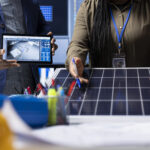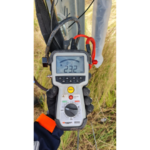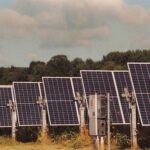In renewable energy engineering, the concept design establishes the foundation of your project, influencing everything from system layout to regulation compliance. With a well-developed concept design, it ensures optimal performance, identifies potential risks early, and provides a path for subsequent phases.
What is Concept Design in Renewable Energy Projects?
It’s the foundational phase where the project’s overall vision takes shape. It involves outlining important elements such as:
- System layout and capacity
- Technology selection
- Site feasibility
- Initial yield estimates
Concept design is also important for determining the project’s technical and financial viability. In fact, it aligns with grid connection requirements and regulatory standards.
Grid Connection and GPS Stage
The concept design stage initiates the grid connection process by supplying key technical inputs such as preliminary single-line diagrams, a proposed point of connection (POC) strategy, and initial load flow assumptions.
These documents form the basis for early engagement with the Distribution Network Service Provider (DNSP) or Transmission Network Service Provider (TNSP). They also support the commencement of Grid Performance Standard (GPS) studies, including load flow modelling, fault level analysis, and system strength assessments.
During this phase, project teams determine the technical approach for connecting to the grid. This includes ensuring compliance with the National Electricity Rules (NER) and any additional requirements set by the Australian Energy Market Operator (AEMO) or the local network service provider. Establishing these details early helps speed up the grid application process and reduces the likelihood of costly design revisions later.
Development Application (DA) Stage
Concept design forms the technical foundation for Development Applications (DAs) submitted to councils or planning authorities. It includes preliminary layouts and electrical drawings that clearly illustrate the project’s scope, footprint, and key infrastructure locations, supporting planning permits.
These early design documents guide a range of DA-related specialist studies. These include geotechnical assessments, biodiversity or ecological reports, noise assessments, and visual impact evaluations.
That said, the concept design’s accuracy and clarity are important. These studies often rely on details such as site layout, access road alignments, inverter and battery placements, and the overall project boundary.
By establishing these parameters early, the concept design phase ensures that all environmental and planning considerations are addressed soundly. As a result, it reduces the risk of delaying the approval process.
Why Concept Design Drives Project Success
A strong concept design helps you set clear project goals. It also helps identify potential challenges early, streamline decision-making, and ensure the project is well-positioned for successful execution. Now, what specific reasons does this contribute to a successful project?
Risk Identification Early On
Early risk identification allows engineers to assess important factors, such as site conditions and grid connectivity, which can significantly impact the project’s feasibility and execution. Identifying risks related to regulatory compliance or technical challenges in renewable energy engineering enables teams to take proactive measures.
For example, a common regulatory-related risk is delays in obtaining environmental permits for solar or wind farm development. To manage this, project teams often conduct early environmental impact assessments.
They also engage with local regulatory bodies during the planning phase to ensure all requirements are addressed and documentation is prepared beforehand. This reduces the risk of costly project delays and helps maintain compliance throughout development.
For site conditions, assessing solar irradiance levels, land topography, and infrastructure access upfront can highlight potential problems affecting energy generation or increasing operational costs. Addressing these issues early on allows you to adjust designs, select appropriate technologies, apply preventive measures to mitigate the issues, or, worst case, change the project’s location to avoid future complications.
Improves Investment Confidence
Investors seek assurance that a project will be completed on time, within budget, and with minimal risk. With a thorough and well-structured concept design phase, it demonstrates that the project has been carefully planned, with potential risks identified and addressed.
In energy engineering, this clarity enables investors to understand the project’s technical and financial aspects, increasing their confidence in its long-term viability. Moreover, a solid design that includes accurate energy yield estimates, proper technology selection, system efficiency, and regulatory compliance assures investors of the project’s potential.
Supports Faster Approvals and Permits
Regulatory bodies and permitting authorities require detailed plans to assess a project’s feasibility and compliance before approval. One of the early requirements is a concept design, which is a set of preliminary drawings and layouts that illustrates the project’s main components, site layout, and intended function. They’re typically developed during the initial planning stages to support the permitting process.
While concept designs are not sufficient on their own to secure permits, they play an important role in the early stages of the regulatory process. A well-prepared concept design helps demonstrate alignment with local planning schemes, zoning rules, and high-level technical and environmental standards. This early clarity can help reduce delays by identifying issues upfront, speeding up the review process, and reducing major redesigns later.
In addition, concept designs show that the project has a solid foundation and is progressing toward detailed design and implementation. This can give regulators greater confidence in the project’s feasibility and its ability to meet environmental, safety, and operational expectations.
Lays the Groundwork for Scalable Engineering
During this phase, engineers outline the system’s specifications, ensuring that the design can be easily adapted or expanded as needed. When electrical regulations, such as the AS/NZS 3000:2018, are incorporated early on, the project is better positioned to meet regulatory standards as it scales.
This proactive approach also helps avoid costly design variations or delays later in the project. By addressing potential upgrades or adjustments during the concept design stage, your team can reduce unexpected changes during construction or operation.
Essentials of High-Quality Concept Design
High-quality concept design ensures every component meets project goals, regulatory requirements, and industry standards. It also guides engineering decisions and speeds up regulatory submissions like renewable energy Development Approvals (DA) and Grid Performance Standard (GPS) packages while confirming technical feasibility for grid integration.
Site Layout and Optimisation
Engineers carefully assess factors such as land topography, solar exposure, and wind patterns to ensure the most efficient use of available space. Strategic equipment placement like solar panels, inverters, and battery systems maximises energy generation while minimising losses and construction complexity.
In renewable energy engineering, an optimised layout also supports easier maintenance, shorter cable runs, and improved safety. Importantly, this layout becomes a reference for planning permits and specialist studies during the solar farm DA process, such as ecological, noise, and visual impact assessments. As a result, the project moves forward with fewer obstacles by setting clear spatial parameters early.
Engineering Design Fundamentals
This phase includes key elements such as technology selection, bill of materials, and system configuration. Each component is carefully tailored to meet the site’s specific needs and project objectives. Technology selection focuses on identifying components that offer the best efficiency, reliability, and compatibility with the overall system.
As for the bill of materials, it outlines the required equipment and quantities, helping manage procurement and budgeting effectively. Meanwhile, system configuration ensures seamless integration and supports load flow assumptions for early discussions with transmission or distribution network service providers (TNSPs/DNSPs).
Overall, these elements help validate the technical feasibility of grid connection and support early GPS requirements submissions.
Preliminary Electrical Schematics
These schematics provide an early blueprint of how electrical components connect and interact within a renewable energy system. These diagrams outline elements like power flows, cable interconnections, and inverters. In general, it gives project stakeholders a clear understanding of the system’s architecture.
Engineering companies use these schematics to identify potential design issues and confirm regulatory compliance. They also ensure all components are properly coordinated before finalising the concept design.
Furthermore, accurate preliminary schematics support smoother contractor communication, utilities, and permitting authorities. As a result, it reduces errors and delays during later project phases.
Energy Yield Reports
Reports of this type estimate how much energy a system will produce over a specific period based on factors such as site location and weather patterns. Commonly used tools like PVsyst, Helioscope, and SAM (System Advisor Model) simulate system performance under real-world conditions to ensure technical viability.
The type of solar modules, inverters, and mounting systems significantly influence these projections. These reports are critical for validating system assumptions and provide a benchmark for post-construction performance monitoring. They also support environmental approval processes by demonstrating that the project can operate within sustainable parameters.
Create High-Quality Concept Design with ElectraGlobe
A well-executed concept design aligns technical planning, regulatory compliance, and risk management to set the stage for efficient construction and long-term performance. Every design element works together to reduce uncertainty and support scalable, cost-effective solutions.
In renewable energy engineering, this early planning phase ensures that a project is viable and optimised for future growth. ElectraGlobe has contributed to numerous projects by delivering high-quality concepts through detailed designs that meet all relevant standards and regulations. With our precision and insight, we help move projects forward confidently, ensuring reliable, high-performance renewable energy systems. For more information, contact us today!
Frequently Asked Questions (FAQs)
If you want to know more about renewable energy engineering, here is additional information that you need to keep in mind:
What is renewable energy engineering?
It focuses on designing, developing, and implementing systems that generate energy from sustainable sources, like solar and wind power. It also combines technical expertise to create efficient, reliable, and environmentally friendly power solutions.
What are the benefits of using renewable energy?
Renewable energy reduces greenhouse gas emissions and decreases reliance on fossil fuels. It also promotes energy independence and supports long-term sustainability.







